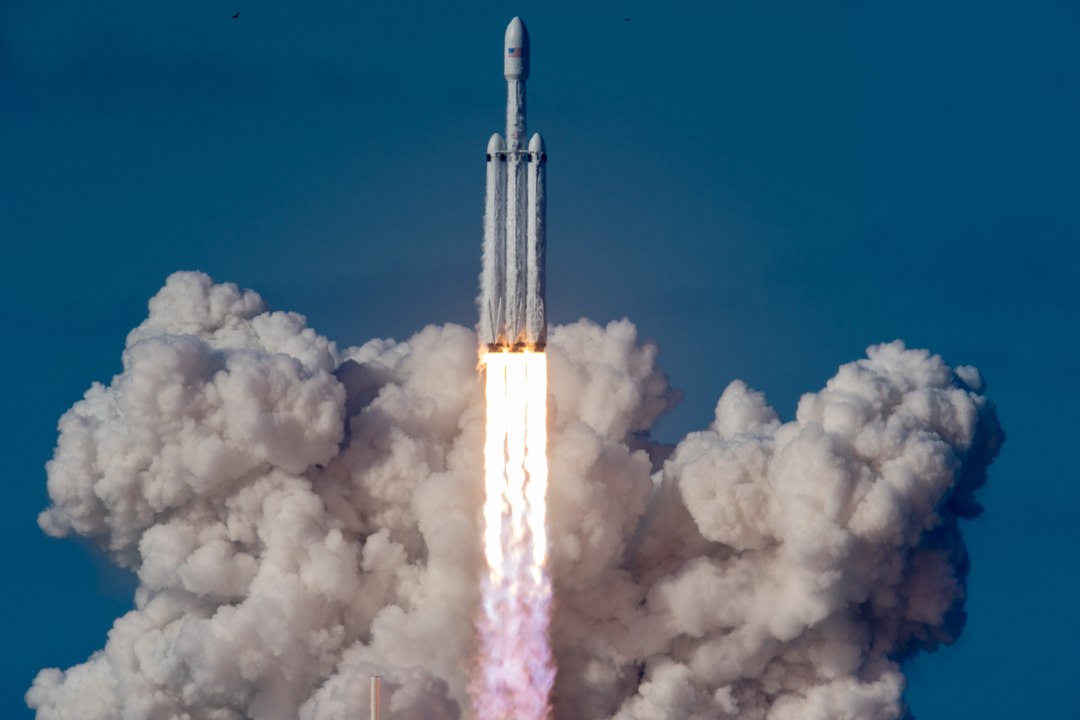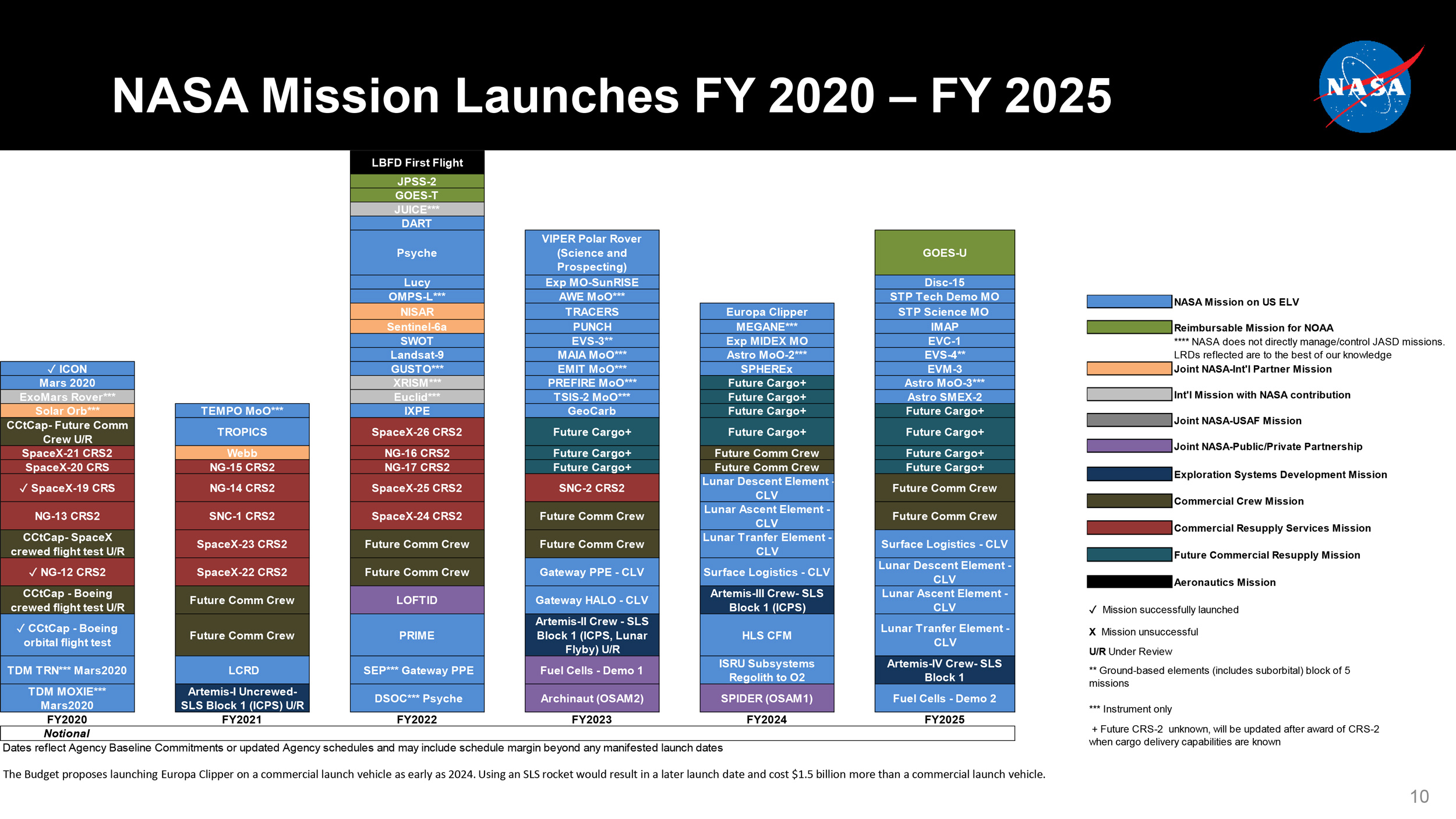The year 2022 is going to be lit! (With NASA space launches.)

2022 is going to be big for science at NASA. A summary of the agency's 2021 budget estimates shows that the fiscal year 2022, which begins on Oct. 1, 2021, will include more than a dozen science-focused missions, ranging from observing the Earth to exploring other worlds to studying faraway galaxies and galaxy clusters.
Below is the full list of these science-focused missions — note that the list leaves off planned deliveries to the International Space Station that could include science equipment and crewed commercial flights that will send astronauts to the station. Many of the listed missions appear to have launch dates falling outside of fiscal year 2022. However, operations for each mission would likely begin in earnest around that time. (One exception to this is Sentinel-6a, which is set to launch in late 2020, yet appears on the fiscal 2022 list.)
Related: Trump calls for $25 billion NASA budget for 2021
The science!
Joint Polar Satellite System-2 (JPSS-2): The goal of this mission is to improve the accuracy, cost and timeliness of climate and weather-related public warnings, NASA said on its website. As the name implies, this will be a polar-orbiting mission completed between multiple agencies (in this case, NASA and the National Oceanic and Atmospheric Administration(NOAA)). Polar missions have the advantage of completing global monitoring from a vantage point that allows them to see the entire Earth below them as our planet rotates. NASA's website notes the mission will launch in March 2022. The mission will include the NASA-supported Ozone Mapping and Profiler Suite-Limb (OMPS-L) instrument to examine the ozone layer and provide ultraviolet index forecasts.
Low-Earth Orbit Flight Test of an Inflatable Decelerator (LOFTID): NASA plans to fly a heat shield (called a cross-cutting aeroshell) high into the atmosphere to see how it performs during reentry, the agency said. NASA is trying to plan how it would deliver heavy equipment (such as astronauts, probes and scientific experiments) to planets with an atmosphere. One probable application would be for a Mars landing in the mid-2030s, in line with NASA's goals for human exploration. LOFTID will catch a ride with the JPSS website, so the two missions will launch at the same time (this launch is currently scheduled for March 2022).
Geostationary Operational Environmental Satellites-T (GOES-T): This is one of a set of weather satellites that operate in geosynchronous orbit, which means they orbit Earth's equatorial plane at the same time that the planet rotates. This allows the satellite to monitor the same region of Earth continuously from an altitude of about 22,300 miles (36,000 km). Both NOAA and NASA are upgrading their current weather satellites in geosynchronous orbit for advanced imagery for Earth's environment, oceans, weather and lightning, as well as examining space weather generated by the sun. This mission was originally scheduled for 2020, but it was delayed until December 2021 after a cooling system problem needed to be addressed. That problem emerged on another satellite in the series called GOES-17, NOAA said on its website.
JUpiter ICy moons Explorer (JUICE): NASA is contributing to three instruments on the JUICE mission, which is a European Space Agency (ESA) mission designed to study three icy moons of Jupiter: Ganymede, Callisto and Europa. Each of these moons is considered to be potentially habitable, so JUICE will gather information about the moons' oceans, surfaces and interiors. JUICE is scheduled to launch in June 2022 and, after multiple planetary flybys, the mission will arrive at Jupiter's system in 2029. The spacecraft is expected to enter the orbit of Ganymede to make observations in 2032, ESA said on its website.
Breaking space news, the latest updates on rocket launches, skywatching events and more!
Double Asteroid Redirection Test (DART): DART aims to test planetary defense technologies against asteroids that may be on a collision course with Earth, NASA said on its website. The mission will slam an impactor into the moon of near-Earth asteroid 65803 Didymos, to see if DART can change its orbit. The moon, which is about 525 feet (160 meters) in diameter, is similar to other near-Earth asteroids that are potentially threatening to Earth, NASA said. An ESA mission called Hera, which is designed to examine the effects of a potential impact from up close, is also in development. Note that DART is scheduled to launch in July 2021 (which is in fiscal year 2021), according to mission participant Johns Hopkins University Applied Physics Laboratory.
Psyche: Psyche will fly to a metal asteroid, which is also called Psyche, to learn more about its nickel-iron core. The information from that will inform our understanding of how planets developed in our young solar system. Scientists aim to use data from this mission to also better understand Earth's core, since our planet's center is inaccessible with current instruments. Psyche's launch date is set for 2022 (which could mean either fiscal year 2022 or 2023), and it will arrive at its destination in 2026 for a 21-month mission examining the asteroid up close, according to NASA. Psyche will carry the Deep Space Optical Communications (DSOC) package to test the concept of using photons (particles of visible light) to send more data in a given period, NASA added on a separate website.
Lucy: Lucy is another mission that will examine asteroids to learn more about the early solar system. It will observe seven Trojan asteroids nearby Jupiter; these Trojans are thought to be part of the early material that formed the outer planets, according to NASA. The mission could also shed light on how life and organic materials arose on Earth. The mission is set to launch in October 2021 and operate for 12 years as it visits the various worlds.
NASA-ISRO Synthetic Aperture Radar (NISAR): NASA and the Indian Space Research Organisation (ISRO) have jointly planned a mission that will examine Earth's environment in detail. This mission's satellite has a broad range of observations planned that focus on environmental change, which could include natural disasters such as tsunamis, ecosystem disturbances and ice-sheet collapses, according to NASA's Jet Propulsion Laboratory (JPL). The overall goal of this mission is to better understand the Earth's crust, climate and processes to assist with disaster management. The mission is set to launch in 2022, JPL's website says, which could mean fiscal year 2022 or 2023.
Sentinel-6a: Sentinel-6 is an ESA mission involving two satellites (Sentinel-6a and -6b) that will be launched a few years apart. Each satellite will have a radar altimeter on board to examine ocean topography and sea rise, according to ESA. Understanding sea level rise helps researchers to better understand and forecast climate change, and the mission's observations of Earth's oceans will help with oceanographic missions in general. NASA will provide a radiometer and NASA's Jet Propulsion Laboratory will supply a GPS receiver to the mission, ESA said on an instrument description page. The launch is set to take place well before the fiscal year 2022, however; 6a should launch in November 2020, ESA states, with 6b following in 2025.
Surface Water and Ocean Topography (SWOT): This will be a joint mission developed by NASA and the French space agency (CNES), and will include participation from other international space agencies. This mission will conduct a global survey of surface water on Earth for the first time, as well as examine the ocean's topography and how bodies of water change, according to NASA. These observations will help scientists with climate change models. This mission is set to launch September 2021, NASA says, which is just before the fiscal 2022 year starts.
Landsat 9: This mission will continue a long-running series of satellites between NASA and the U.S. Geological Survey which observe change on Earth. This satellite series will focus on land resources and examine how these resources affect items such as human health, ecosystem function and resource management, NASA said on its website. Landsat 9 is meant to join Landsat 8, a satellite with a five-year life span that launched in 2013 (and is still operating) and replace Landsat 7, which launched in 1999. While the mission is listed under 2022 on NASA's chart, it is set to fly in March 2021 (which would fall in fiscal year 2021). NASA's website says that the mission will go "as soon as possible" to reduce a data gap in observations if Landsat 7 fails.
Galactic/Extragalactic ULDB Spectroscopic Terahertz Observatory (GUSTO): This high-altitude balloon telescope will examine the material between stars, which is also known as the interstellar medium, NASA said. The goal of this mission is to develop insights into how interstellar gas behaves in space, as gas plays a crucial role in forming or dissolving star-forming clouds. The mission also aims to better study how gas flows around the center of our galaxy. The launch date is scheduled for December 2021, NASA said on a separate website.
X-Ray Imaging and Spectroscopy Mission (XRISM): This mission is led by NASA and the Japanese Aerospace Exploration Agency (JAXA). Its goal is to examine X-ray-emitting objects in space using spectroscopy, or a form of observation that analyzes objects by their emitted or reflected light. NASA will contribute the Resolve soft X-ray spectrometer detector, several Resolve subsystems, an X-ray mirror assembly and a soft X-ray imager, NASA stated. The mission is set to launch in early 2022, NASA said on another website.
Euclid: Euclid is an ESA-led mission that aims to uncover more about the nature of dark matter and dark energy, which together make up most of the energy and mass known in the universe. The mission will examine the shapes of galaxies and galaxy clusters to better understand how dark energy and dark matter formed and shaped large cosmic structures over billions of years, ESA said. NASA's contributions to this mission include infrared detectors for one instrument as well as science and data analysis, NASA said on its website. Various ESA web pages say that Euclid will launch in 2022, sometimes further specifying "mid-2022."
Imaging X-ray Polarimetry Explorer (IXPE): This NASA-led mission will examine how X-rays are produced in objects such as neutron stars (superdense star cores left over after supernova explosions), nebulas (gas clouds) and various sizes of black holes, according to the agency. The mission is supposed to launch in April 2021, NASA said, which is well before fiscal year 2022.
Correction: A previous version of this story stated that Landsat 9 would replace Landsat 8. The Earth-observing satellite will actually join Landsat 8 in orbit, and is designed as a replacement for the older Landsat 7.
- NASA's Artemis moon program just photobombed a spacewalk (photo)
- The Orion spacecraft for NASA's 2020 trip around the moon is ready
- Will Apollo nostalgia help NASA get its Artemis moon money?
Follow Elizabeth Howell on Twitter @howellspace. Follow us on Twitter @Spacedotcom and on Facebook.
OFFER: Save at least 56% with our latest magazine deal!
All About Space magazine takes you on an awe-inspiring journey through our solar system and beyond, from the amazing technology and spacecraft that enables humanity to venture into orbit, to the complexities of space science.

Elizabeth Howell (she/her), Ph.D., was a staff writer in the spaceflight channel between 2022 and 2024 specializing in Canadian space news. She was contributing writer for Space.com for 10 years from 2012 to 2024. Elizabeth's reporting includes multiple exclusives with the White House, leading world coverage about a lost-and-found space tomato on the International Space Station, witnessing five human spaceflight launches on two continents, flying parabolic, working inside a spacesuit, and participating in a simulated Mars mission. Her latest book, "Why Am I Taller?" (ECW Press, 2022) is co-written with astronaut Dave Williams.


